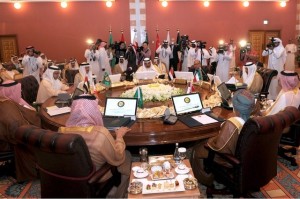by Kristian Coates Ulrichsen
As soccer’s governing body gathers in Miami on March 14-15, the vexed question of whether to bring forward the expansion of the FIFA World Cup, currently scheduled for the 2026 tournament in North America, to Qatar 2022 has again reared its head. Reports suggest that the 37 members of the FIFA Council will consider an 81-page feasibility study that FIFA conducted into the practicalities of expanding the 2022 tournament from 32 to 48 teams and holding games in one or more other Gulf states. Although little about the 2022 World Cup has been straightforward in the eight years since Sepp Blatter pulled Qatar’s name out of a white envelope that snowy December day in Zurich, expanding the tournament would be a mistake, for multiple reasons.
As things stand currently, Qatar 2022 will be the most compact tournament since the inaugural World Cup in Uruguay in 1930, in which 13 teams took part and all games were played in the capital, Montevideo, spread across three stadiums. In Qatar, by comparison, eight stadiums in five municipalities will be used, with the farthest—the Al-Bayt Stadium in Al Khor—just 30 miles from Doha. Jose Mourinho, the decorated ex-Chelsea, Real Madrid, and Manchester United coach, praised the compact nature of the tournament during a visit to Qatar in January 2019 as he noted that the short distance between stadiums would benefit players and spectators alike. This stands in stark contrast to the World Cups either side of 2022, in Russia in 2018 and the United States, Canada, and Mexico in 2026, with some venues separated by more than 1,000 miles and multiple time-zones. If FIFA is serious in marketing its flagship event as a global festival where supporters from across the world come together over a shared love of soccer, Qatar 2022 could become the most fan-friendly tournament in modern times.
Over the decades, the World Cup has expanded from 16 participating teams between 1934 and 1978 to 24 from 1982 to 1994. The 32-nation format has been in place since the 1998 World Cup in France. The increase in the number of teams has steadily diluted what initially was a European- and South American-heavy event and contributed to the global allure of a tournament that now provides FIFA with up to 95 percent of its revenue through the sale of licensing, television, marketing, and hospitality rights. By and large, the expansion has also had a positive impact on the quality of the soccer as well, with mismatches such as Brazil’s 9-0 win over Zaire in 1974 and Hungary’s 10-1 thrashing of El Salvador in 1982 largely a thing of the past, and only Saudi Arabia’s 8-0 capitulation to Germany in 2002 coming close in recent times.
One of the advantages of both the 16- and 32-team tournament, and a drawback of the 24-nation iterations, was a streamlined character whereby two countries qualified from each four-team group into a series of knockout rounds that led directly to the final. This symmetrical progression had more than just aesthetic value as it made less likely the sort of informal collusion that sometimes occurred in the 24-team tournaments when only 8 teams were eliminated after the first round and teams knew they could advance as a third-place group finisher in certain circumstances, such as in 1990, when the Irish and Dutch captains signaled to each other mid-game that a draw would take both countries through at the expense of Egypt.
In a 48-team format, which FIFA already has approved for 2026, the first round would consist of 16 groups of three rather than the current eight groups of four. This means that one team would sit out each round of matches, including the final game in the group that could decide which team(s) qualify for the knockout phase. Once again, there is the potential for collusion if the two teams playing the final group game know that a specific result could allow them both to qualify at the expense of the third team that had already completed its two group games. Not for nothing did FIFA introduce the concept of the final group games taking place simultaneously after the disgraceful scenes of the “Anschluss” at the 1982 World Cup in Spain where West Germany beat Austria 1-0 to secure a result that qualified both teams and eliminated Algeria, which had played its final game the previous day. The Algerians could only watch with a sense of outrage shared by a local Spanish newspaper, which printed the game report in its crime section.
Why Expansion?
FIFA’s president, Gianni Infantino, seems set on pushing ahead with the expansion of 48 teams and bringing it forward to 2022, mindful perhaps of the popularity of such a move ahead of the full FIFA Congress in Paris in June. Although Infantino faces no challenge to his re-election as FIFA president, it makes electoral sense for him to appeal to as many confederal and national soccer associations worldwide by increasing the number of coveted World Cup spots by 50 percent. Infantino’s plans have, however, sparked intense opposition from UEFA, the governing body of European soccer, which derailed a controversial $25 billion pledge of investment by an unnamed consortium, rumored to involve Japanese- and Saudi-backed interests, that Infantino had hoped to force through FIFA last year. UEFA President Aleksander Ceferin took direct aim at Infantino when he stated caustically in June 2018 that “I cannot accept that some people who are blinded by the pursuit of profit are considering to sell the soul of football tournaments to nebulous private interests.”
The bad blood between UEFA and FIFA is likely to resurface if or when the FIFA Council is asked to formally study the feasibility study to expand Qatar 2022. UEFA opposed moving the tournament to November-December due to the impact this would have on the European soccer season and did so on the condition that the World Cup be shortened from the month-long event to 28 days. The feasibility study has proposed to schedule an unwieldy six games per day in the opening group rounds to squeeze the additional matches into a shortened schedule. Such a plan smacks of desperation and overkill by a FIFA leadership intent on sacrificing quality for quantity and placing its own commercial interests over and above sporting ones.
Perhaps the single biggest reason for opposing any expansion is also the suggestion that Qatar be asked to add one or two other host countries in the Gulf, which makes little geopolitical sense. Qatar has faced a blockade by Saudi Arabia, Bahrain, and the UAE since June 2017, which may have stemmed in part from a desire to force Qatar either to give up or to share the World Cup. In October 2017, the head of Dubai Security tweeted that “If the World Cup leaves Qatar the crisis will go away…because the crisis is created to break it.” So, there is a very real risk that adding Kuwait and/or Oman as co-hosts could expose them to the same kind of power-play that has broken apart Gulf politics since 2017. Perhaps with an eye on a future career as a mediator, or even as a candidate for a Nobel Peace Prize, Infantino said in February that “If Donald Trump can meet with Kim Jong-Un, then everything is possible!”
Impact of Blockade
Setting aside the fact that the Trump-Kim meetings hardly constitute a positive model to emulate—whether in process, planning, or policy outcome—Infantino’s comments betrayed an ignorance of the levels of regional mistrust and anger that make any reconciliation around the World Cup unfathomable at present. The pettiness displayed by the UAE in hosting the recent Asian Cup (won, with considerable aplomb, by Qatar) has surely dispelled any notion that the country is fit to stage a major international sporting tournament in its present condition. From not allowing Qatari supporters to enter the country to support their team to throwing shoes at Qatari players during their 4-0 semi-final victory over the UAE to downgrading the trophy ceremony in an apparent fit of pique at Qatar’s triumph, the UAE inflicted damage to its sporting reputation that surpasses the $150,000 fine imposed by the Disciplinary and Ethics Committee of the Asian Football Confederation.
The blockade has affected the World Cup in other ways too. Qatar had committed to securing a proportion of construction materials from other Gulf countries to spread the economic benefits of hosting the tournament. Cities like Dubai could have hosted supporters who would have made the short flight to Doha on gamedays. Meanwhile, thousands of Saudis, Emiratis, and Bahrainis were expected to attend the games.
There is also considerable irony that the wheel has come full circle exactly 10 years after FIFA rejected a suggestion from the Qatari bid team in March 2009 that some games take place in other Gulf cities to make it a World Cup for the region. That there is still a strong sense of regional pride in the World Cup and a desire to be a part of it is borne out by the number of applications to volunteer at Qatar 2022 from Saudi Arabia, Bahrain, and even the UAE, despite the risks and difficulties in accessing the registration website. Absent any political resolution to the blockade, the greatest pity may well be that soccer-mad citizens of Saudi Arabia, Bahrain, and the UAE are prevented by their governments from attending the regional celebration of the Middle East’s first World Cup right on their doorstep.
Kristian Coates Ulrichsen is a Fellow for the Middle East at Rice University’s Baker Institute for Public Policy.





